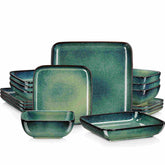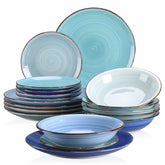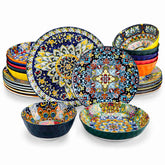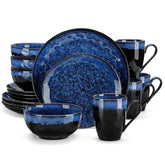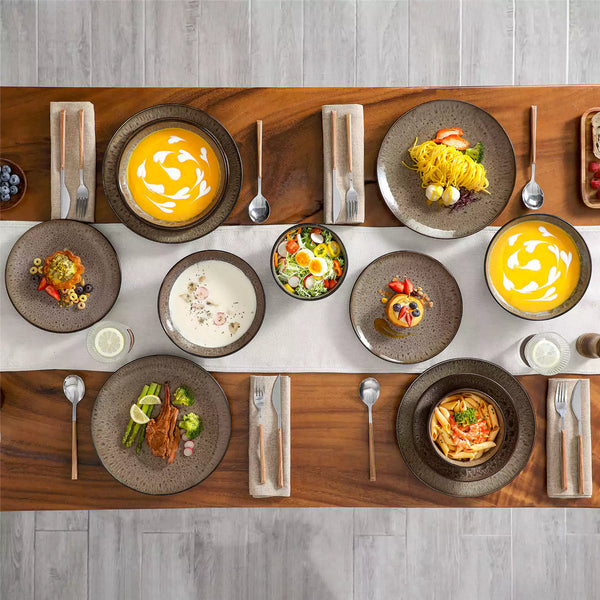Is Your Stoneware Dinnerware Truly Non-Toxic? What You Need to Know
When we are having a meal, we tend to concentrate on the food, its taste, texture, and presentation. We seldom doubt the plates underneath it. But what happens when your exquisitely designed stoneware dinnerware is releasing poisonous chemicals into your food? As health and safety awareness increases, the question on the lips of many is: Is my stoneware dinnerware really non-toxic?
This is not just a valid question but a necessary one. The use of non-toxic dinnerware has become a significant issue to families that are pursuing a healthy lifestyle. Knowledge of what makes dinnerware safe and what materials may be harmful is critical to making informed dining decisions.
What is Stoneware?
Stoneware is a ceramic dinnerware that is created using a specific type of clay that is fired at high temperatures, usually between 2,100 and 2,300 degrees Fahrenheit. The outcome is a heavy, hard, and non-porous material that is commonly used in both informal and formal dining. Stoneware tends to be a bit rustic or earthy in look and the glaze contributes to its beauty. Stoneware is not as porous and fragile as earthenware, and it does not chip or absorb water, which makes it usable in everyday life. This however does not necessarily mean that it is non-toxic. The glazes and materials that it is made of play a major role in determining whether it is indeed safe to come into contact with food.
What Does Non-Toxic Mean for Your Dinnerware?
By non-toxic dinnerware, we mean dinnerware that does not contain any harmful chemicals that may leach into your food. This encompasses materials that do not emit heavy metals such as lead or cadmium, which have been traditionally used in glazes to add color and luster. Non-toxic also means no industrial toxins like BPA, phthalates, and PFAS-chemicals more often used in plastics but sometimes used in lower-quality ceramic coatings or finishes. Authentic non-toxic dinnerware is tested thoroughly and usually complies or surpasses FDA or California Proposition 65 safety requirements. To the consumer, non-toxic should not be a marketing term but a tangible safety guarantee.
What Toxins Should You Watch Out for in Stoneware?
Although stoneware is usually safer than plastic or low-grade ceramic, it is not free of possible contamination. The following are the most prevalent toxins in certain stoneware products:
Lead: Commonly applied in glazes to produce bright colors and shiny surfaces. Lead may leach into food unless fired properly.
Cadmium: A metal used to produce bright reds, oranges and yellows. It is toxic like lead when consumed.
BPA (Bisphenol A): Commonly used in plastics, although certain stoneware products with decorative finishes can also contain BPA.
Phthalates: These are plasticizers that are occasionally used in the coating or packaging of dishware.
PFAS (Per- and polyfluoroalkyl substances): These are also called forever chemicals and may be found in stain-resistant or water-repellent coatings.
Stoneware that is imported or handmade, particularly in countries with less strict safety standards, is more likely to have these toxins.
What Health Risks Come from Toxic Stoneware Dinnerware?
Toxins in dinnerware are not just a technical issue, but a real health hazard. Prolonged exposure to lead and cadmium, even in low doses, has been associated with severe medical conditions. The brain and nervous system may be affected by lead poisoning, especially in children, and lead to developmental delays and behavioral problems. Kidney damage and bone loss are linked to cadmium exposure. BPA and phthalates interfere with the endocrine system, which may cause hormonal imbalances, reproductive issues, and even some cancers. PFAS chemicals are associated with immune system suppression, high cholesterol, and cancer risks. Essentially, you may be slowly poisoning yourself by using toxic stoneware on a regular basis.
How to Identify Potentially Risky Stoneware
In order to safeguard your family, you should know how to identify stoneware that might not be non-toxic. The following are some of the main tips:
Seek Certification: Select stoneware that is labeled as lead-free, cadmium-free, or certified by third-party standards such as the FDA or Prop 65.
Country of Origin: Be cautious of products made in countries with lax safety standards. Not everything imported is harmful, but it is essential to be transparent.
Avoid Bright Colors and Metallic Glazes: These are attractive to the eye, but they are usually made with heavy metals.
Question to the Brand: Responsible manufacturers will reveal how their products are tested in terms of safety. When the information is unclear or absent, it should be viewed as a red flag.
DIY Testing Kits: Lead-testing kits can be purchased to use at home and can provide reassurance when testing older or suspect items.
Look at Chipping or Cracks: Broken glazes may enhance the chances of chemical leaching.
Reputable stoneware brands tend to be transparent about their materials and testing procedures. A good sign of a safety-conscious brand is transparency.
What Other Non-Toxic Dinnerware Options Are Available?
Although stoneware is good, other dinnerware can provide superior non-toxic assurances based on your requirements:
Porcelain: Porcelain is fired at very high temperatures and is non-porous and less prone to leaching toxins. Preferably, use lead-free ones.
Glass: Borosilicate and tempered glass are typically regarded as among the safest food contact materials. This is why brands such as Pyrex are popular.
Stainless Steel: Stainless steel is a good choice when it comes to outdoor dining and children, as it is durable, non-reactive, and contains no heavy metals such as lead or cadmium.
Bamboo or Wood (with Caution): These are environmentally friendly and fashionable, but they can absorb liquids and might have glues or resins that are not non-toxic. Make sure they are food-safe and BPA-free at all times.
All the materials have their advantages and disadvantages, yet the final decision to use non-toxic materials is based on transparency and reliable sources.
How to Dine Safely with Your Stoneware Dinnerware
You do not need to sacrifice the aesthetic and functional value of stoneware with the proper precautions. Pay attention to quality products manufactured by well-reviewed companies that are transparent about their safety levels. Avoid dollar-store items or antique items that are used to serve everyday meals unless they have been tested to be free of lead and cadmium. Remember that even safe stoneware must be used with care, do not use it when the glaze is chipped, or when it has been exposed to sudden changes of temperature which may have damaged the coating.
By educating yourself and making informed decisions, you are in charge of the health of your family. It is not only about purchasing beautiful dishes, but also about making the dining experience safer and healthier to all people sitting at the table.
Keep Your Stoneware Dinnerware Non-Toxic
Stoneware dinnerware, with its rustic beauty and durable construction, can actually be a safe and fashionable addition to your table, provided you take the necessary precautions to make sure it is non-toxic. Consumers now have the means to make informed choices, whether it is knowing what the term non-toxic actually means, or what red flags to look out for in questionable products. Although the dangers of toxins such as lead, cadmium, and BPA are not imaginary, they can be prevented through proper research and intelligent purchasing.
In today’s health-conscious world, what you eat on is as important as what you eat. When you are buying new stoneware or assessing the plates you already have in your kitchen, knowledge is your best defense. Eat wisely, eat in peace.


